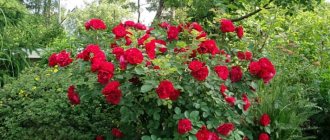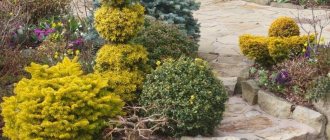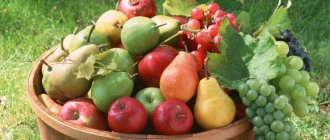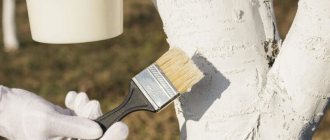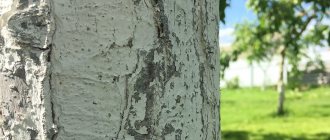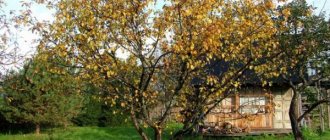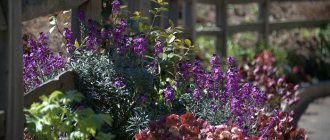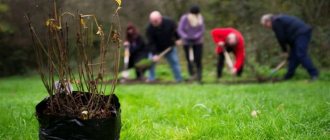Importance of the procedure
Work in the garden begins as soon as the snow melts - this is the most favorable moment for processing garden trees. About half a century ago, whitewash was applied to each trunk in the form of lime mortar. Now this composition has been replaced by a garden type of paint, more effective and practical. Trees should be painted twice a year - in spring and autumn. This ensures their reliable protection from external influences.
In early spring, it is important not to miss the moment when the snow has already melted and the soil has not yet warmed up. The need to comply with this condition is caused by the fact that insects wintering in the ground have not come out of hibernation. If you whitewash the trunk in time, they will not be able to climb it and harm the plant. Those pests that wait out the cold season in the folds of the bark, thanks to the paint, find themselves firmly sealed in it and soon die.
In autumn it is also very important to treat garden trees. The composition of the whitewash serves to protect the surface of the trunk from freezing, and with the onset of thaw, from overheating under the spring sun. Typically, painting is carried out when the air temperature drops to +2…+5°C.
How to whitewash trees
To the most common question - to what height to whiten - experienced gardeners answer:
- entire trunk (this is the trunk from the root collar to the first skeletal branch of the lower tier)
- plus the lower skeletal branches by 1/3 of their length (many even 1/2 of the length of the branches are whitened).
As they say, to protect is to protect! By and large, it would be nice to cover the entire tree in such a light-repellent shell, but this is a labor-intensive and expensive task. Although such examples occur quite often)
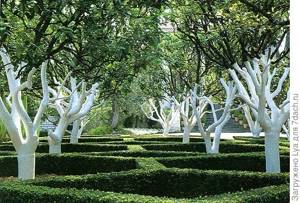
Lime or paint?
In the recent past, all gardeners treated their plantings exclusively with a composition based on slaked lime. There is an opinion that using this method of protection runs the risk of harming trees, especially young ones. You can make a less concentrated solution, thereby reducing the possibility of damage. There is no point in giving up painting, as it is a very important part of garden care.
Lime whitewash can be purchased ready-made or made with your own hands. It is important not to forget to add the adhesive component - otherwise the composition will be washed off the trunk after the first rain. To make the mixture you need:
- dilute slaked lime in a ratio of 2 kg per bucket of water (10 l);
- add 250 g of copper sulfate;
- add 1 kg of fatty clay to the resulting mixture.
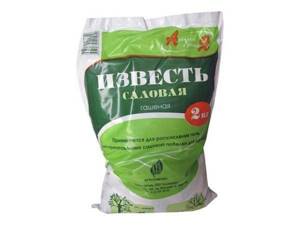
Sometimes cow dung is also added to the solution. The finished composition should have a consistency similar to liquid sour cream so that it does not flow down the tree trunk during the whitewashing process. If this happens, then you need to add a little more clay.
However, despite its simplicity and availability, lime tends to wash off fairly quickly, and it does not provide 100% protection against pests.
As an alternative to this method, special garden paint has been developed.
Benefits of paint
Modern means have a number of advantages over proven, but rather outdated types of processing:
- They guarantee protection not only from insects, but also from rodents.
- Reliably protect the tree trunk from possible sunburn.
- The paint is suitable for absolutely any plant.
- Moisture resistance increases significantly.
- You don't have to worry about trees in severe frosts.
- Whitewashing with paint can be used in places where branches have been cut or broken instead of special means.
- Protects the trunk from harmful insects that settle in the folds of the bark.
- After treatment, you can forget about diseases such as fruit rot, rust, scab and many others. There is an option, in addition to standard whitewashing, to treat the entire crown of the plant with paint diluted with water (1:10) using a sprayer. This will not only prevent diseases, but also protect against acid precipitation and the appearance of lichen on the branches.
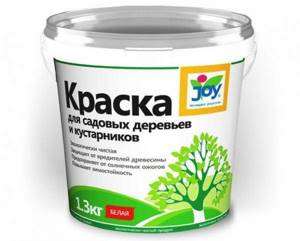
Do you need to whitewash trees?
To understand the meaning of whitewashing, we need to say a few words about tree bark , which, in fact, is whitened. Bark for a tree is like skin for a person: protecting internal organs, it is the first to meet all unfavorable environmental conditions.
And there are many of them: sharp temperature fluctuations, biting winds, hot sun and severe frosts, the teeth of rodents, the action of pests, and even people themselves with their habit of building a fire under a tree and carving their immortal name or the message “Vasya + Katya = love” on the bark. The bark gets sunburned and frostbite, becomes rough and cracks, hurts and peels off. Who among us has not seen the difference between the smooth skin of a young seedling and the rough, cracked bark of an old one? And everyone also knows what a skin injury leads to: illness: infections and pests penetrate the body, weaken it, and lead to premature withering and death. Therefore, the tree bark must be protected .
This is what whitewashing is for, it:
protects the tree bark from burns - winter and early spring, when for natural reasons there is simply no foliage that serves as protection from the sun;
- protects against temperature changes , which means it prevents cracking of the bark (the appearance of frost holes);
- helps protect against insect pests , the larvae of which settle in the bark.
So treating whitewashing trees as a purely decorative event is a mistake. Many years of experience of gardeners clearly shows: this is an effective protective measure for the bark.
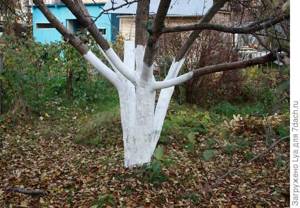
The most effective formulations
The most popular among gardeners is ordinary water-based acrylic paint. Thanks to its composition, it adheres perfectly to the surface of the trunk and at the same time allows the bark to breathe. It should be applied in warm weather, when the temperature rises above +5°C. It is also important to carry out treatment in the absence of precipitation and strong wind.
In addition to the basic protective properties, whitewashing with water-based paint protects plants from harmful microorganisms. To improve the effectiveness of repelling pests, you can add substances containing copper to the composition. Before application, acrylic paint must be thoroughly stirred and, if necessary, slightly diluted with water (maximum 10% of the paint volume). The trunk is treated in one layer, and for damaged areas it is important to use the composition undiluted.
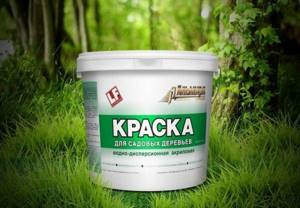
The second fairly common type is “Luck” paint. It is moisture resistant and maximum safety for plants. This composition can be used to treat young trees once a year, and older trees once every two years. Easily applied using a brush or a regular roller. It is important to paint only in dry weather.
The common water-based paint “Almira” is applied under the same conditions as the types listed above. Before painting a tree, it is worth preparing the surface of the trunk: remove the old bark and treat the damage.
Preparing for work
Whitewash can be applied only to those plants that have already begun to bear fruit. Young seedlings purchased last season may not tolerate this procedure and die. They are usually wrapped for protection with any covering material other than plastic film.
Before starting processing, it is important to properly prepare the trees. They must be carefully cleaned of diseased and old bark, moss and lichen. To remove lichen, you can use a special solution. It is prepared as follows: 1 kg of salt, 2.5 kg of ash and two pieces of pre-crushed laundry soap are mixed in one container. Then you need to pour in a bucket of hot water and boil. Use a cooled mixture to wash off all the moss from the trunks. It is best to separate the old bark by hand, since the use of scrapers, brushes and spatulas can injure the plant.

If fresh damage is found on the tree, they must be treated with garden varnish. Instead, they often use a mixture of clay and manure, oil paint or beeswax with the addition of rosin.
Before you start bleaching, you can additionally coat the trunks with a disinfectant composition.
Painting tools
When whitewashing plants with lime mortar, sponge brushes were usually used in the past. At present, they have practically been abandoned, using tools with artificial bristles of a similar shape to apply the compositions. They are in no way inferior to their predecessors, allowing you to quickly and efficiently paint any surface. Particularly resourceful gardeners carry out the treatment with several brushes tied together.
If you have to whitewash a large number of trees, especially old ones, then it would be wise to use a spray gun for this. In this case, it is necessary to apply the composition in two layers instead of the usual one.
How to paint trees
Whitewashing is carried out in dry weather so that rain or snow does not wash away the fresh paint. In mature trees, the trunk (the lower part of the trunk) and the thick (skeletal) branches adjacent to it are whitened. These parts of the plant are the most vulnerable: they cannot recover when damaged, as roots or young shoots do.
Seedlings and young plants 1-2 years old are not painted to avoid damage to the thin, delicate bark. If necessary, resort to other measures to protect against frost, burns and rodents: tying with spruce branches or covering material, installing fine mesh.
Preparing trunks for processing
The trunk of apple, plum, pear and other fruit trees needs to be cleaned and disinfected before autumn painting.
This procedure is performed to prevent fungal infections of wood and to better fix the coloring composition on the bark.
Preparatory work is carried out in several stages:
- Burlap or a piece of thick fabric is spread under the crown.
- Using a plastic or wooden scraper, clean the trunk of mosses, lichens, and dry fragments of bark.
- A disinfectant solution prepared from copper sulfate, stove ash, green soap, or a ready-made industrial composition is applied to the cleaned surface.
- Large cracks, damage, and hollows are cleaned and sealed with garden varnish.
- If necessary, remove dry branches and trim the crown.
To prevent the spread of pathogenic microorganisms throughout the garden, the protective fabric is burned along with the garbage. It is better to do this outside the site.
Methods of applying paint to wood
It is more convenient to apply paint from top to bottom: this avoids smudges. The layer should not exceed 2 mm in thickness so that the wood can “breathe”.
The trunks are whitened with the following tools:
- Paint brush. For work, choose a wide, flat brush with artificial bristles. Adult plants can be painted with poppy seed, as it allows you to immediately cover a large area of bark.
- Spray gun. This method is suitable for those who have many fruit trees growing in their garden. The spray gun economically consumes paint and varnish material, applying it in an even thin layer.
- Paint roller. With this tool, paint is applied quickly, easily and evenly. However, it is not able to cover hard-to-reach areas as well as a brush. Therefore, whitewashing with a roller is recommended for smooth trunks without visible damage.
Whitewashing is carried out in October-November after the end of the period of autumn showers and the air temperature drops to -2...-3°C.
Tree trunks covered with white composition give the garden as a whole a special and festive look. But it is clear to everyone that gardeners periodically renew the whiteness of their trunks not at all in order to give them a special design. First of all, the treatment of trunks in spring and autumn is carried out solely in order to protect them from the harmful effects of ultraviolet rays.
